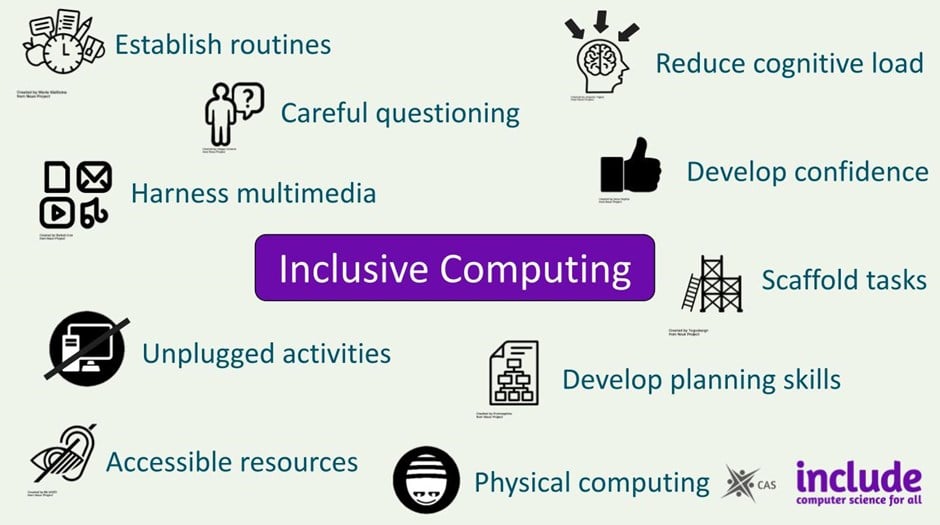15 December 2021
Twenty things to make your computing lessons more inclusive

The Computing at School working party CAS Include (https://www.computingatschool.org.uk/about-us/cas-working-groups/cas-include) is committed to increasing diversity and inclusion in computing, and has recently developed two resources to support teachers in the classroom. The 10 Things Inclusion presentation has ten ideas to make lessons more inclusive for students who may experience barriers to learning for example due to additional needs, or English as an additional language. The 10 Things Diversity presentation includes ways of engaging all students in computing, regardless of their gender, ethnicity, socio-economic status, or any other individual identities that are traditionally under-represented in the subject.
10 Things Inclusion
Some of the things are related to high-quality teaching, which benefits all learners, for example thinking about how you ask questions, developing confidence, and establishing routines to reduce anxiety. Other more specific things to consider:
- What you as the teacher can do
Consider the presentation of information, so that learners can access content and aren’t overwhelmed. This might mean presenting smaller chunks of information, using image support, or changing the layout of content to include plenty of white space and features such as lists or titles to help students make sense of what is there. When introducing new concepts, use familiar contexts to help illustrate these to reduce the amount of new information being presented to the learner. For example, we can introduce the idea of algorithms as a sequence of instructions to make a cup of tea – but how many younger pupils know how to make a cup of tea? It would be much better to use a familiar context such as washing hands, or getting dressed.
- What the student does
The ‘Use-Modify-Create’ framework (ref) is useful to provide learners with different ways to engage with content. Some students may run and investigate working code, other can make simple modifications to a program, and another group may be creating their own version of an activity. This allows all learners to be included in a lesson, but at a level suitable to their current understanding. Gradually these scaffolds can be removed as students become more confident.
Physical computing devices are great for engaging learners, for eliciting quick wins and providing a concrete, sensory output for an abstract program – for example making a robot move, lighting up LEDs, or playing a sound. Providing multiple ways for learners to engage with and express their learning, allows lessons to be more inclusive.
10 Things Diversity
Every student brings their own individual mix of experiences and interests to the classroom. As teachers, we need to acknowledge these differences and provide a safe space for all young people to engage with computing as a subject. This presentation has a number of suggestions for how to do this.
- What the student does
Allow students to experience pair programming and collaborative working, which is proven to engage girls. Ensure your curriculum is culturally responsive – are you including contexts and projects that are relevant to the young people in your classroom? Teach a broad and creative curriculum, with plenty of opportunities to develop the strengths of you students in the different strands of computing.
- What you as the teacher can do
Celebrate diverse and relevant role models, helping students to ‘see’ themselves in computing-related careers. Consider your language – is it gender-neutral and culturally sensitive?
Provide accessible homework tasks, that don’t rely on students having access to technology at home (or a space and time for them to complete work at school). Link to free and open-source tools and resources, so that all students can use these.
So go take a look at the resources and see what you can start to introduce in your lessons to make them more inclusive. We’d love to hear of any great ideas and successes in the forum.









Discussion
Please login to post a comment
What a great topic to address and discuss. Role models are so important. It still surprises me how strong the gender bias stereotype is. Another good way to address inclusivity is in the questioning/exam questions. One of my exam questions involves a nurse and his boyfriend. Every year students question if I meant a her or a doctor. Whilst not specific to computing, it helps promote that we are a diverse and inclusive classroom thus making students feel comfortable in class.
Hi Pete, happy new year! I’d like to say I was super efficient and knowledgeable and set all this up myself. But all I did was write a blog post, I had no idea it opened up a discussion thread too - how exciting
Thanks Catherine, really interesting read with helpful suggestions.
I’m trying to get my head around the new CAS site and like how you shared a blog post and set up a discussion thread about it, with Neil’s comment displaying on both the blog page and the discussion. Did the site set up the discussion thread automatically from the blog post or did you do that yourself?
Thank you!
Thanks for sharing Catherine. Lots to think about here
Neil